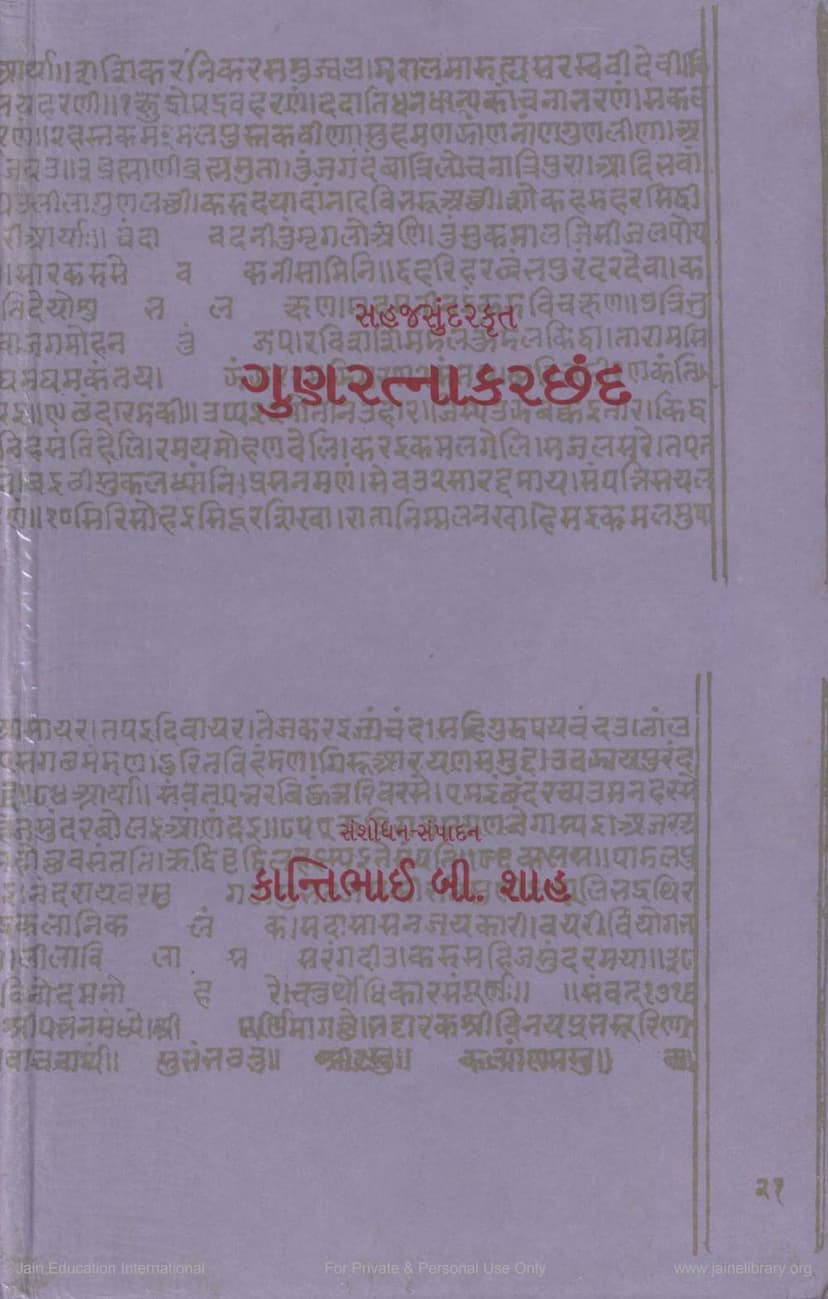Gunratnakarchand
Added to library: September 1, 2025

Summary
Here is a comprehensive summary of the Jain text "Gunratnakarachand" by Sahajsundar, as edited by Kantibhai B. Shah:
Title: Gunratnakarachand Author: Sahajsundar Editor/Researcher: Dr. Kantibhai B. Shah Publisher: Shree Shrutgyan Prasarak Sabha, Ahmedabad Publication Year: 1998
Overview:
"Gunratnakarachand" is a significant medieval Gujarati Jain poetic work composed by Sahajsundar, dating back to the Vikram Samvat 1572 (CE 1516). This long narrative poem, divided into four chapters (Adhikars) and comprising 419 verses (kadis), narrates the famous Jain legend of Sthulibhadra and the courtesan Kosha. The work is praised for its poetic qualities, rich descriptions, and the skillful use of various metrical forms (chhandas), reflecting the tradition of charani (bardic) literature.
Key Features and Content:
-
Author and Context: Sahajsundar was a Jain monk poet belonging to the Upakesha Gachchha. His lifespan is estimated to be around CE 1514-1539. While his works are primarily devotional and didactic, they also showcase his deep understanding of literature, philosophy, and the nuances of human life. "Gunratnakarachand" is considered his masterpiece.
-
Subject Matter: The poem centers on the life story of Sthulibhadra, a Jain monk renowned for his spiritual prowess and his ability to overcome worldly temptations. The narrative specifically highlights his encounter with the beautiful and accomplished courtesan Kosha. Despite her attempts to entice him with worldly pleasures, Sthulibhadra remains steadfast in his spiritual path. The poem explores themes of renunciation, detachment, spiritual discipline, and the ultimate triumph of righteousness over desire.
-
Structure and Composition:
- The "Gunratnakarachand" is structured into four Adhikars (chapters).
- It comprises 419 verses (kadis).
- The poem is characterized by its extensive use of diverse metrical forms (chhandas), particularly those prevalent in the charani (bardic) tradition. This includes various meters like Āya, Reḍakī, Dūhā, Triyaṁgī, Līlāvatī, Vr̥ddhanārāca, Sārasī, Paḍdhaḍī, Hāṭakī, Bhujangaprayāt, and Muktādāma, among others. The skillful integration of these meters contributes to the poem's musicality and rhythmic flow.
- The language is medieval Gujarati, rich with vocabulary, including Sanskritized terms, local dialect influences (like Rajasthani), and the evocative use of words that create sound and rhythm (r̥vānukārī śabdāvalī).
-
Poetic Merit:
- Vivid Descriptions: Sahajsundar excels in descriptive passages. The poem vividly portrays various settings, from cities and royal courts to natural landscapes and opulent residences. The descriptions of Sthulibhadra's spiritual discipline, Kosha's beauty and seductive arts, and the celestial realms are particularly noteworthy.
- Emotional Depth: The poem delves into the emotional complexities of the characters, especially Kosha's inner turmoil, her attempts to win Sthulibhadra, and her eventual transformation. It also captures Sthulibhadra's inner resolve and spiritual struggle.
- Figurative Language: The poet employs a rich array of figures of speech, including metaphors, similes, hyperbole, and alliteration (śabdānuprās, āntarprās), enhancing the poetic appeal and impact of the narrative.
- Didactic Purpose: While rich in poetic artistry, the underlying purpose of the poem is spiritual and moral instruction. It aims to guide readers towards detachment from worldly pleasures and adherence to Jain principles of renunciation and devotion.
-
Scholarly Edition: The presented edition, meticulously researched and edited by Dr. Kantibhai B. Shah, is highly commendable. It includes:
- Critical Reading: Based on a thorough study of multiple manuscripts (21 identified, with 10 used for critical analysis).
- Textual Variants: Detailed recording and discussion of textual variations found in the manuscripts.
- Prose Translation (Gadyānūvād): A clear and accessible Gujarati prose translation of each verse, aiding comprehension.
- Verse Commentary (Vivarana): Explanations and insights into the meaning, context, and literary devices used in each verse.
- Introduction and Analysis: Comprehensive introductory sections covering the author, the narrative sources, the genre of 'chhanda' in Gujarati literature, and a detailed review of the "Gunratnakarachand" itself.
- Word Glossary: An extensive glossary of words used in the text, aiding in understanding the medieval vocabulary.
Significance:
The publication of "Gunratnakarachand" by Shree Shrutgyan Prasarak Sabha is a valuable contribution to the study of medieval Gujarati literature, particularly Jain literature. Dr. Kantibhai B. Shah's scholarly work brings to light a significant but previously unpublished work, making Sahajsundar's poetic genius accessible to a wider audience. The text serves as a testament to the literary and spiritual richness of Jain traditions and the sophisticated metrical artistry of medieval Gujarat. It also highlights the Jain community's tradition of preserving manuscripts and fostering scholarly research.